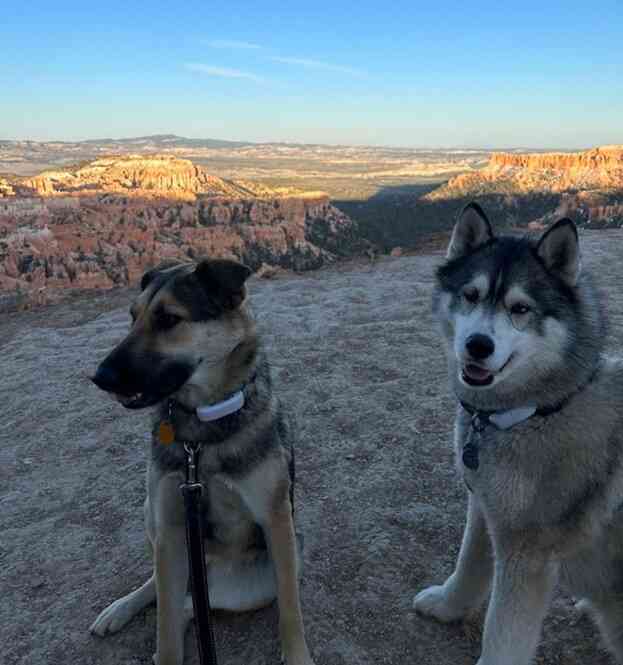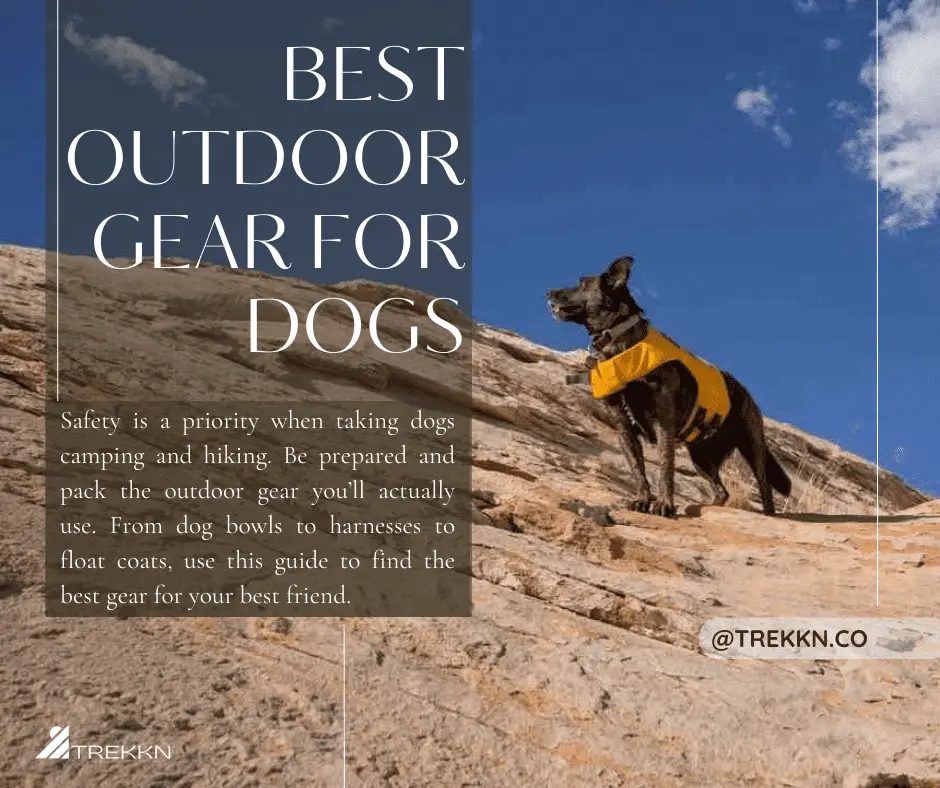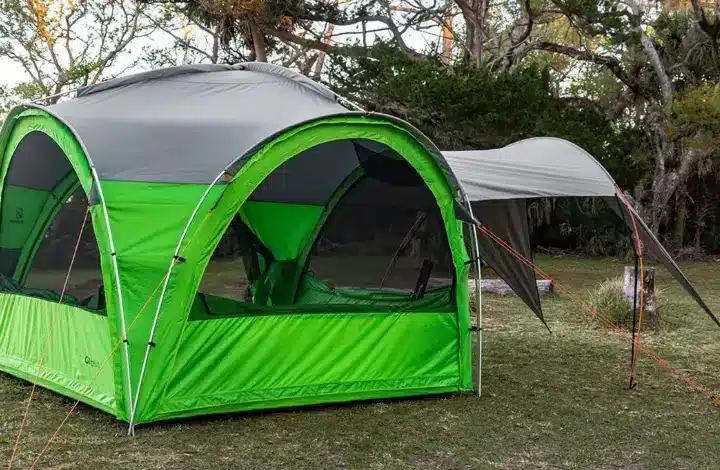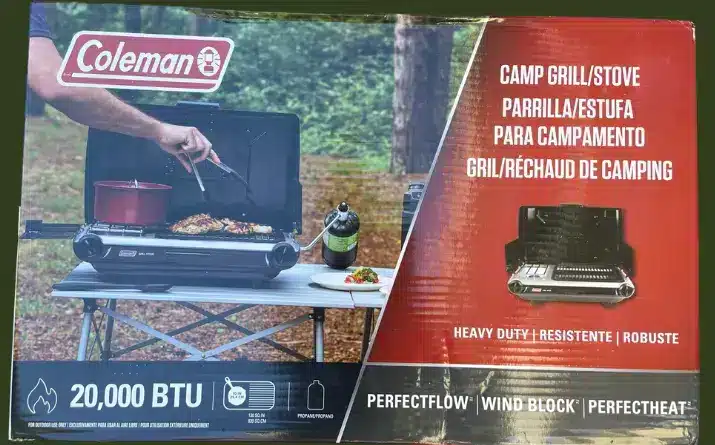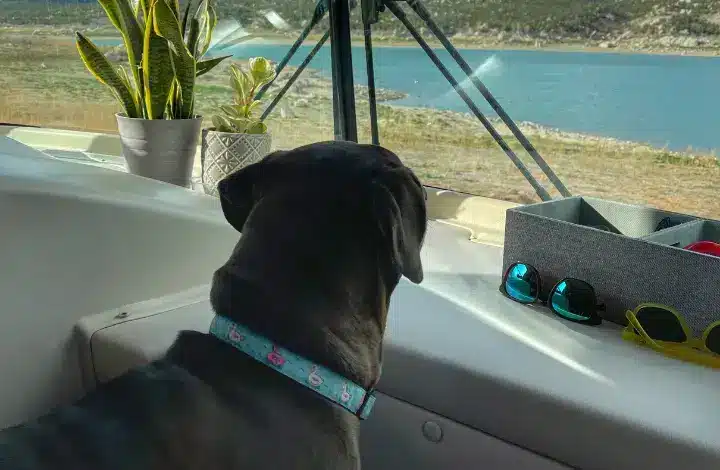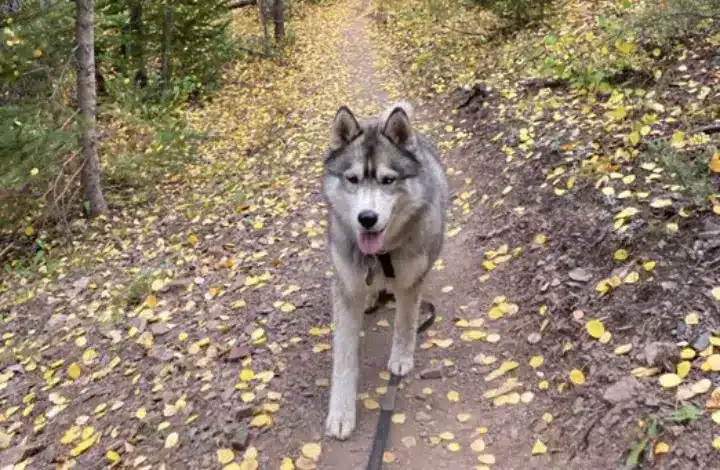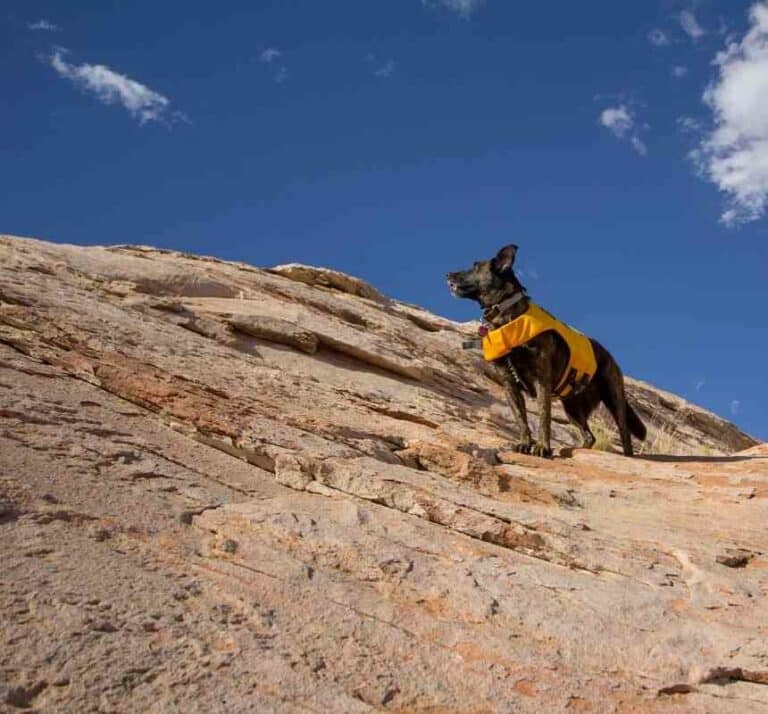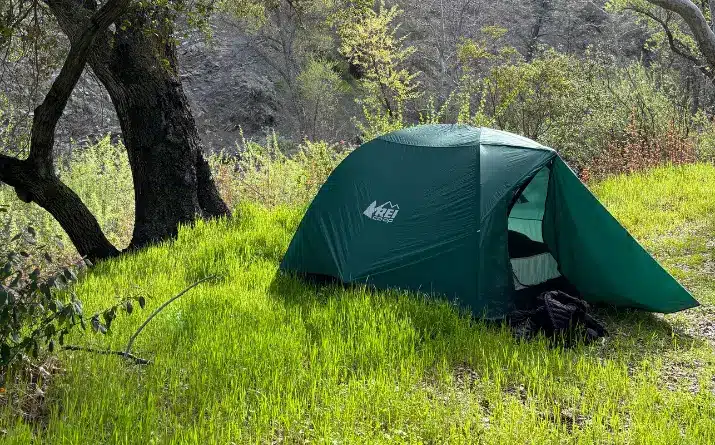How to Keep Dogs Safe While Camping
I love camping with my dogs. But that wasn’t always the case. My first-ever campout with my dog Orion was a near-disaster. I learned a lot from that experience, including how to plan and pack the right gear to keep my dogs safe while camping. That’s the focus of this guide.
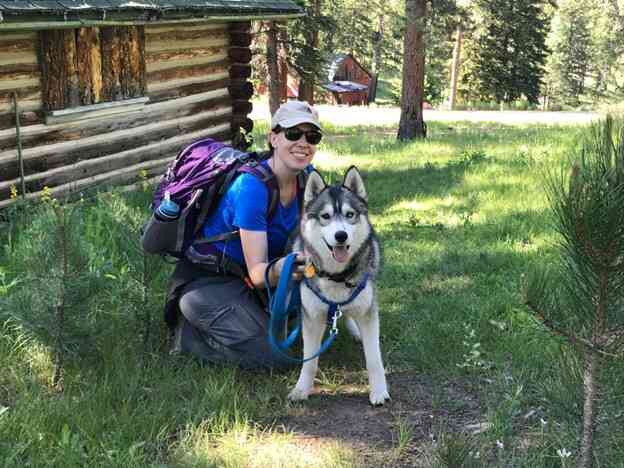
First, let me tell you what happened.
He was still a puppy, not fully potty trained and definitely not capable of spending time in a tent without trying to rip apart the seams.
If I had known what I was getting myself into, I would have planned that trip much differently.
While the tent didn’t survive our first night outdoors, I learned a lot from that first outing. Orion and I have been camping together happily ever since.
Camping is an ideal experience for anyone looking to reconnect with nature and escape the daily grind. And if you can bring your dog along, it’s practically perfect!
Whether you’re car camping or exploring remote areas of the backcountry on foot, keeping your dog (and the local wildlife) safe while you’re out there should always be a top priority.
In this article, we’ll talk through how to keep your canine companion safe, happy, and living their best leave-no-trace life so you can continue camping with them for many years to come.
Related Reading: Leave No Trace Is Important
Should Your Dog Go Camping?
My boyfriend and I once brought our dog along on a family campout. We put her safely in my parents’ pop up trailer while we went to a nearby town to get supplies for dinner.
When we got back, we found her pacing around our campsite awaiting our return. Her separation anxiety had gotten so bad that she’d chewed right through the canvas siding and jumped out while we were away.
In retrospect, we shouldn’t have left her alone for any amount of time; camping was just a bit too stressful for her.
Determine if Your Dog is a Camping Dog
Before you and your dog hit the road, it’s important that you understand your own dog. Make sure they will enjoy the experience of camping.
WILL THE CAMPSITE BE A GOOD FIT FOR YOUR DOG?
Consider the area where you plan to camp and all the possible scenarios, including whether or not there might be times when you need to leave him with friends at the campsite. Then decide whether that is a fit for your dog.
Some dogs love nothing more than to snuggle up with their humans in the woods. Others are naturally anxious and will keep themselves (and you) awake all night pacing and barking.
Senior dogs with health and mobility issues may struggle walking on unpaved, uneven trails. Some dogs may not have aced their “basic manners” training to stay calm and quiet at a campground.
Remember, for first time camping dogs, these areas are a 24/7 parade of new sights, sounds, and smells.
Related Reading: Essential Accessories for RV Adventures with Your Dogs
Puppies who aren’t yet housebroken and who can’t be left alone will pose additional challenges for their owners.
If any of these attributes describe your dog, you may want to leave them at home with a pet sitter instead of bringing them along on your next camping adventure.
TAKE YOUR DOGS ON A CAMPING TEST RUN
If you’re not sure, do a test run in the backyard or at a local campground. Check how your dog responds to the unfamiliar situation. Even taking them on an extended outdoor picnic can help you prepare to keep your dogs safe on your next camping trip.
If your dog is ready and able to camp, take their personality and activity level into account. A short-legged, low-energy dog is probably not well suited for a week-long backpacking trip.
Caring for a high-energy puppy will make it tough for you to relax at the campsite all weekend.
Don’t forget that fear is a very real factor for dogs. Shy and cautious dogs might get overwhelmed if you push them out of their comfort zones too quickly.
All of this is to say that not all dogs enjoy all experiences, so tailor your camping trip to your pup’s personality and abilities to ensure you both have the best possible time.
Top Tips to Keep Dogs Safe While Camping
With that PSA out of the way, let’s dive into the practical tips that will keep your dog safe while camping.
Preparation is Key
RESEARCH YOUR DESTINATION
Before hitting the road, check the pet regulations and guidelines at your destination. While most national and state parks allow pets, many have restrictions on where they’re allowed to go.
For example, dogs may be allowed in the campground, but not on the hiking trails. So do your research before you leave.
You don’t want to get excited about that long morning hike only to find out later that you’ll have to skip it completely. By knowing what to expect you can plan activities accordingly, which will help both you and your pet enjoy the camping experience.
SCHEDULE CHECKUP WITH VET BEFORE LEAVING
Make sure your dog has a clean bill of health before you leave town. They should have updated vaccinations, including one for Leptospirosis if you think your dog might drink from unfiltered water sources.
Keep them current on heartworm prevention and consider adding flea and tick prevention during the summer months or in high-risk areas.
PACK ESSENTIAL CAMPING GEAR FOR YOUR DOG
You have camping gear—your dog should, too! Plan ahead and use a checklist to ensure you pack all the gear you need to keep your dogs safe while camping. Your canine camping kit should include a few essential items:
Your canine camping kit should include a few essential items:
Stay tuned. A bit further down in this article we provide a deep dive into the must-have camping gear for your dog.
Secure Your Campsite
KEEP YOUR DOG CLOSE
Even if your dog is friendly and well-behaved, keep her leashed or on a tether if she isn’t under bombproof voice command, or if you can’t keep an eye on her.
This helps prevent your dog from chasing wildlife and also ensures they stay safe from potential predators.
Never leave your dog at camp unattended, ever. Not only is it unsafe for your pup, but most campgrounds have strict rules about this.
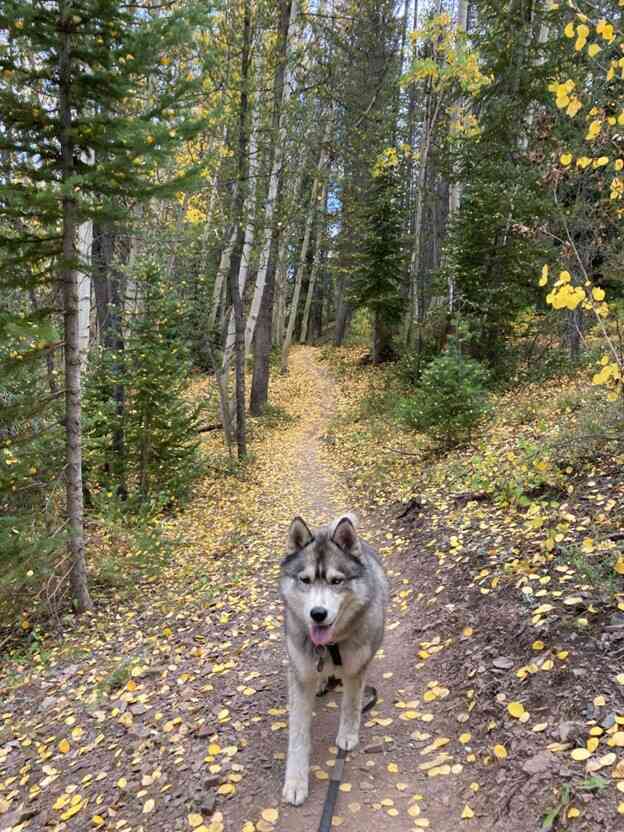
TREKKN is ready-supported. We may earn a small commission for qualifying purchases, at no additional cost to you. Please read our disclosure for more information.
AVOID TOXIC PLANTS
Check the area around your campsite to ensure there aren’t any dangerous plants, like poison ivy. Check for flowers that are poisonous to dogs, such as daffodils or foxglove.
While you’re at it, keep all the human food out of reach. This will keep it safe from both your pup as well as the local wildlife such as raccoons, skunks, and bears that will be scavenging after dark.
Chocolate, grapes, onions, alcohol, and marijuana can all be poisonous to dogs, so keep those items secure while you’re in camp.
BE AWARE OF LOCAL WILDLIFE
As campers and hikers, we remain diligent and aware of the more common and well-known safety precautions when it comes to wildlife.
Secure your food in bear-safe containers and avoid tall grassy areas to prevent encounters with snakes.
It’s also important to know about any local wildlife that poses a specific threat to dogs. If you’re camping in Texas or Florida, for example, be aware that the skin glands of the Bufo frog secrete a toxin that is lethal to dogs.
So, do your research and, as mentioned above, keep your dog close.
Outdoor Adventure Tips
SHARE THE TRAIL
Keep your dog on leash where the rules say you should; it’s for your dog’s protection as much as for the wildlife.
Also, if your dog isn’t under solid voice command, they could alarm other hikers or get into scuffles with reactive dogs on trail. Pull your dog off trail and allow other hikers to pass as needed; not everyone is comfortable around dogs, so it’s a good idea to respect everyone’s space.
CARE FOR THE PAWS
Hiking in rough or rocky terrain can tear up your dog’s paws, especially if they’re used to walking on dirt or concrete.
You may want to invest in protective dog booties, especially if you’re backpacking or taking long hikes in the backcountry.
Trail-ready boots for dogs protect paws on rough terrain. Available in various sizes and colors.
STAY HYDRATED
Dogs need a lot of water when they’re running around outside! Never let them drink from stagnant water sources, and try your best to carry clean, filtered water for them to drink. Keep an eye out for signs of heat exhaustion, which can quickly turn deadly in dogs.
Related Reading: How to Filter Water on a Hike
PLAN DOG-FRIENDLY ACTIVITIES
The whole point of camping with your dog is to spend time with them, so plan activities that they can also enjoy. Unless you have a fully hard-sided RV with temperature control, never leave your dog unattended at camp while you venture out to enjoy a humans-only activity.
Whether your dog prefers hiking, relaxing at the beach, boating, or exploring dog-friendly open spaces, plan activities that allows you to bring your dog with you.
And, depending on the activity, please ensure you have the right gear. If you’re going paddle boarding together, don’t forget to outfit your pup with a doggie life jacket.
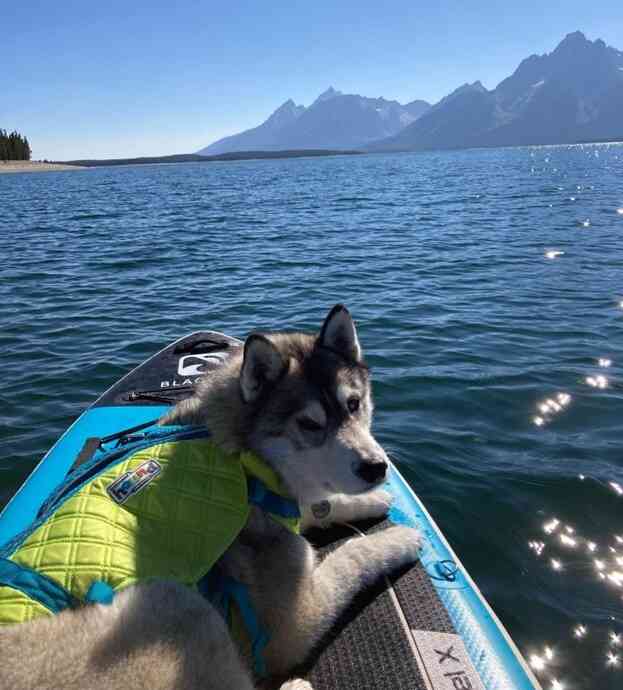
Available in various sizes. Measure dog's chest girth to purchase appropriate size. Top handle provides extra safety measure to lift dog out of water if needed.
CHECK YOUR DOG FOR TICKS
When you’re back at camp after a day of adventuring, check your dog for ticks, especially if you’ve been in wooded or grassy areas.
Those little hitchhikers are much easier to find when they’ve only been on your dog for a short time, as they tend to climb around for a while before they find a spot to attach.
If you find any, remove them with a tick remover or tweezers and drop them in rubbing alcohol to kill them.
Prepare and Keep Watch for Wildlife
PRACTICE VOICE COMMAND TRAINING AHEAD OF YOUR TRIP
Before you leave home, teach your dog commands like “leave it,” “stay,” and come when called to help prevent them from chasing wildlife.
This is especially important in rattlesnake country, or if you’re camping in the mountains where you might encounter moose, mountain lions, or bears.
NIGHT SAFETY
Predators get more active at night, so keep your dog inside your tent or car. They should sleep with you—not alone—in a secure space where they can’t wander off or come face-to-face with a predator.
Predators get more active at night, so keep your dog inside your tent or car. They should sleep with you—not alone—in a secure space where they can’t wander off or come face-to-face with a predator.
Attaching loud items to your dog, such as bear bells or jangly ID tags, can help other animals hear your dog approach and prevent an unpleasant surprise.
Adding an LED light collar will make sure you can find them in the darkness.
Easily attach to belt, backpack straps, or dog collar/harness with a hook and loop closure to alert wildlife you're in area. Magnet in bag silences bell when not in use.
Expect the Best, Plan for the Worst
KNOW YOUR DOG’S LIMITATIONS
If your dog isn’t used to long hikes or rugged terrain, start small and dial your adventures up from there. For instance, you might start with some gentle weekend car camping and regular day hikes before taking your dog on a multi-day backpacking adventure.
FIRST AID
Learn a few basic canine first-aid practices, especially if you’ll be in the backcountry. Knowing how to handle unforeseen injuries can make the difference between an enjoyable campout and a panicked trip to the emergency vet.
On top of standard first aid gear, keep your dog’s medical records accessible. You never know when you might need them. One option is to make copies and save digital files to a cloud server so you can access the information from any device. This can come in handy if you need to go to a new vet.
A dog first aid kit should include:
A simple bandana can also come in handy. It can be soaked in cold water and tied around your dog’s neck to cool them down if they get too warm in the sun.
This portable medical kit designed to help you care for your dog includes sterile bandages, antiseptic, allergy medicine, and other first aid supplies.
MAKE A PLAN IN ADVANCE
Put together a list of the closest veterinary offices, including at least one urgent care center that is open 24/7. You can either make a handwritten list or drop pins in an app like Google Maps so they’re easy to find in a pinch.
If you’re camping in remote backcountry, make sure you have a way to evacuate your dog in case of severe injury or illness. Carriers like Ruffwear’s BackTrak Dog Evacuation Kit might add some gear to your pack, but they’re invaluable in the event of an emergency, especially with a large dog who you may not be able to carry out.
Related Reading: RV Temperature Monitor Review to Help Keep Dogs Safe
Carry Essential Outdoor Gear When Camping with Dogs
Must-Have Outdoor Dog Gear
There are a few things you should carry with you no matter where you overnight with your dog, and camping is no exception.
POOP BAGS
Yes, you still need to pack out your dog’s poop even while camping. Dogs don’t eat the same diet as wild animals, so their poop isn’t part of the natural environment. Plus, it’s not cool to leave any piles behind for the next camper to step in.
So bring bags and pack your dog’s poop out with you. If you don’t want to use plastic, there are plastic-free biodegradable bags. Alternatively, you can bury your dog’s deposits as carefully as you do your own. If you bury the waste, make sure you do so at least 200 feet from any water source.
FOOD AND WATER BOWLS
It probably goes without saying, but I’ll say it anyway. Don’t bring ceramic bowls from home. They’re way too heavy for camping or hiking and break easily. Lightweight, collapsible bowls are perfect for camping with dogs.
DOG FOOD AND DOG TREATS
Use Tupperware containers or gallon-size zip-close bags as lightweight dog food storage. If you’ll be out for more than a week or two, consider switching your dog to a dehydrated food from Rawbble before you travel. Dehydrated food is lightweight and easy to store. You can also supplement these travel-friendly options with your dog’s regular kibble.
IDENTIFICATION
Make sure your dog is microchipped and wearing a collar with tags displaying your current phone number.
You might also consider a GPS tracker for some extra peace of mind if you have a dog who might wander away from camp.
Real-time tracking to locate and track dog anywhere. Subscription required.
- Real-time tracking
- No distance limit
- Battery-operated with battery life up to 15 days
TIE OUT OR ZIP LINE
You can’t keep an eye on your dog every second. And with lots of exciting new wildlife around, you can’t always count on them to stick around camp—even if they do well at home.
Use a tie-out cable with a corkscrew stake or a “zip line”—heavy-duty rope tied between two trees that you can attach to your dog’s leash with a carabiner—to give your dog some freedom while ensuring they stick around.
An overhead dog lead is great for keeping dogs tethered and safe while camping. Available in various colors and lengths, including 50', 70', and 100'.
SLEEPING GEAR
Unless you want to share your sleeping bag with your dog, you’d better bring one for them, too! A sleeping pad can be combined with a dog bed or sleeping bag on top to insulate your dog from the cold ground.
Portable, water-resistant, and machine-washable travel bed for dogs. Check size to purchase bed size that fits your dog.
Related Reading: Top Sleeping Pads for Camping
Have Fun Camping with Your Dog!
Camping with your dog can be a memorable experience and the perfect bonding opportunity. I wouldn’t trade any of the camping memories I have with my dogs—not even the memory when one dog burst through the canvas of my parents’ old pop up trailer.
While there are never any guarantees when it comes to nature, you can plan and prepare to put the odds in your favor that your camping adventures are safe and enjoyable.
Whether you’re exploring a bustling national park or seeking solitude in the backcountry, putting your dog’s safety first helps ensure countless more adventures together.
Related Reading: Essential Tips for Dog Safety While Hiking
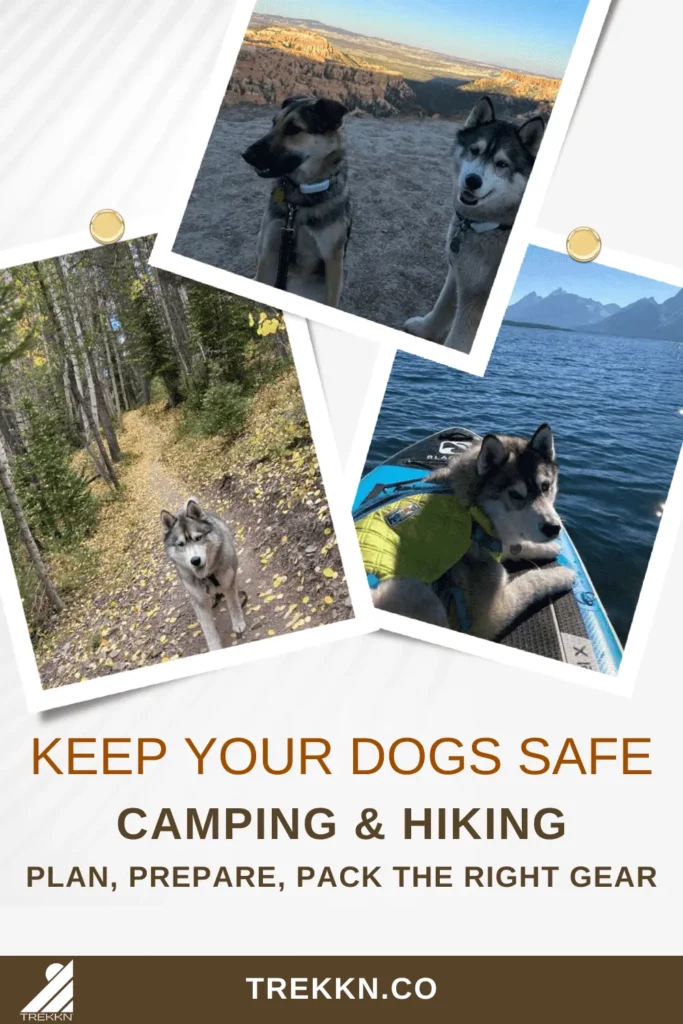
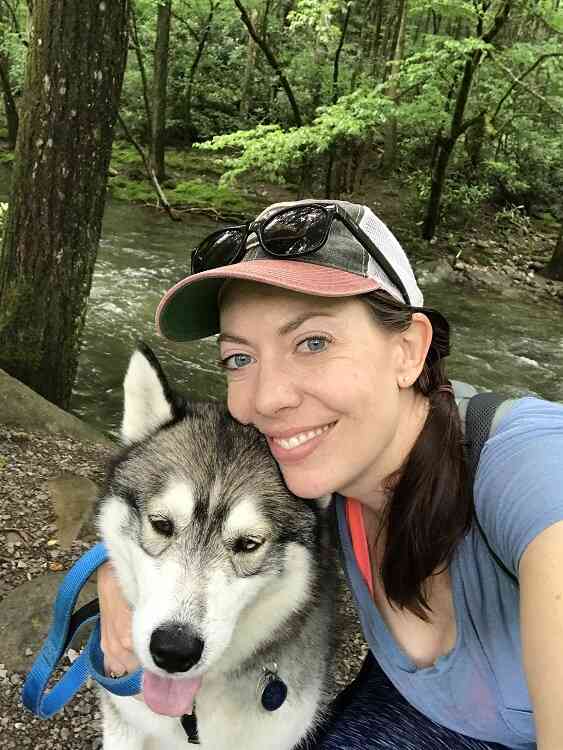
Sarah Kuiken has been a full-time solo traveler for 4 years and counting, but she’s been a solo adventurer for decades. She owns her own copywriting business, Flourish Writing, which she operates from the road. Sarah loves to explore state and national parks with her two dogs, Orion and Piper—wherever they’re allowed, of course. When she’s not whipping up web copy for fellow entrepreneurs, she’s probably out hiking or paddle boarding with the dogs in tow. Learn more about her freelance writing business at FlourishWriting.com.


